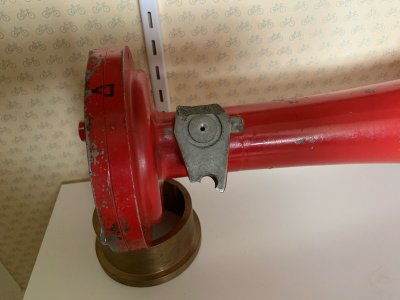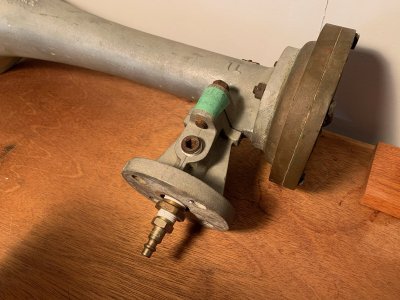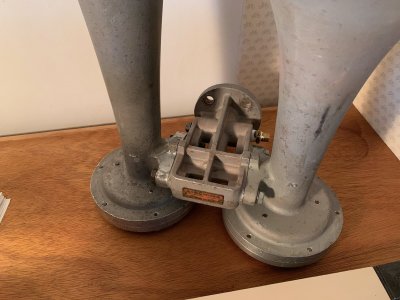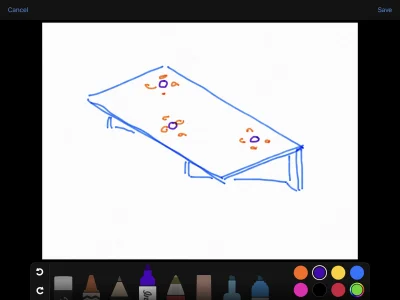Chicken lights
Forum Pony Express Driver
Surprise
They are a K2 and a K4Nice! Die cast K-1?, die cast K-2?, and what’s the little guy?
Any suggestions on a mounting bracket? Cut a 4” circle out of 1” aluminum then drill and tap the centre for 1/2” NPT?Got it, thanks. Forgot the other one was from earlier.



What do you mean, don’t you have any??Wait...why do you have train horns Frank?
Oh, you should be golden then. They usually pipe straight into that female thread with a whatever-length nipple and that flange gets bolted straight to cab roof or wherever with a rubber gasket between. You could make an adapter plate or (transition plate might be a better term) depending on what you’re mounting or if you don’t want to run pipe straight through.That’s what’s on the red one. I just picked 1” arbitrarily, the threads on that one are quite deep
I suck at drawings but I was thinking to make a 90 degree plate to bolt all three to, and mount them on one of the frame crossmembers. I’ve ordered in a couple brass T’s to build a manifold, but still looking at optionsOh, you should be golden then. They usually pipe straight into that female thread with a whatever-length nipple and that flange gets bolted straight to cab roof or wherever with a rubber gasket between. You could make an adapter plate or (transition plate might be a better term) depending on what you’re mounting or if you don’t want to run pipe straight through.
I threaded quick connect fittings into the bases of mine so I could decouple them from a single air source but that was just for convenience.
I thought some of the history behind them was cool, that’s why I posted a couple links at the start of thisWhat do you mean, don’t you have any??
Seriously, long story and as if often true with long stories ‘... it all started with one small one...’ and went sideways from there. In these parts they’re often called whistles after the actual steam whistles that were on the donkey engines in the bush, and even though technically they’re horns the whistle term still holds.
Why do I have them? There’s a logging connection in the extended family, coastal loggers like boats, boats need whistles, and I’ve been known to be good at restoring things. That’s how it started, and then we just thought they were really cool and were positioned to collect a few. I also lucked into an Airchime whistle control console (also ex-RCN) from back in the day when Capital Iron still sold real salvage. Others came from the bush.
They’re a neat part of our coastal history, and I still like having them around. Just need to figure how to mount one on a sewing machine now....
Nope! A friend aired up the lil’ red horn and our ears rang for a good hour afterwards. I knew enough to be 50 feet away and still it was loud.Ha! I'm curious did you air up the lil' red riding horn and find it lacking ?
A chord is much better than a single note.
With your border pick- ups for forum members you could add "Blockade Runner " to "Forum Bootlegger"
That sounds reasonable. Something like this, if I’m understanding correctly...I was thinking to make a 90 degree plate to bolt all three to, and mount them on one of the frame crossmember

Nope! A friend aired up the lil’ red horn and our ears rang for a good hour afterwards. I knew enough to be 50 feet away and still it was loud.
Ha! I like blockade runner
That’s exactly how they were mounted on the other truck, and I planned something similarWhile reading the last couple days postings in this thread i was thinking when I got to the end i would suggest to you, Dave, that you mount that unit as far back from the cab as you can...I guess you know that already....and point it back.
If you have them all plumbed and mounted as a unit you can still get a sense of each ones tone by just plugging two at a time with a rag in the muzzle. it really is amazing how each one will have a completely different blast tone but it takes all three in unison to really create the locomotive warning. I agree that they are "air hogs"...those needles on your air tanks are going to move quicker with a horn blast that they will in a panic breaking episode ( according to Stan, my buddy of the RR crossing story)
Now just hook them up to the garage door and wait for the lowlifes to come! ........ Maybe a sign
“ TP available at house”
